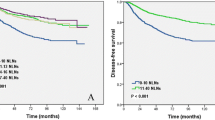Abstract
Background
The ratio of positive lymph nodes between the total number of harvested lymph nodes (metastatic lymph node ratio, MLNR) has been proposed as an alternative to the total number of lymph nodes alone in predicting outcomes for patients with breast cancer. Because there can be differences between European and non-European populations, the authors present the first study analyzing MLNR influence over disease-free survival (DFS) by using a population-based cancer registry in a European country.
Methods
Data from 441 patients with T1-2 N1-3 breast cancer included in the Castellon Cancer Registry (Comunidad Valenciana, Spain) were used. Cumulative DFS was determined using the Kaplan-Meier method, with univariate comparisons between groups through the log-rank test. The Cox proportional hazards model was used for multivariate analysis.
Results
At univariate analysis, factors influencing the 10-year DFS rate were tumor size, conservative or nonconservative surgery, histologic grade, histologic type, radiotherapy, tamoxifen, estrogen and progesterone receptor status, p53 status, total number of positive lymph nodes, and MLNR. At multivariate analysis, tumor size, MLNR, and progesterone receptor status were revealed to be independent prognostic factors; the metastatic lymph node ratio was the most notably independent factor (hazard ratio 1.02, 5.21, and 0.61, respectively).
Conclusions
MLNR is a stronger prognostic factor for recurrence than the total number of positive lymph nodes in T1-T2 N1-3 breast cancer.



Similar content being viewed by others
References
Caigang L, Ping L, Yang L et al (2007) Clinical implications of metastatic lymph node ratio in gastric cancer. BMC Cancer 7:200
Chang-Ming H, Bi-Juan L, Hui-Shan L et al (2008) Prognostic impact of metastatic lymph node ratio in advanced gastric cancer from cardia and fundus. World J Gastroenterol 14:4383–4388
Slidell MB, Chang DC, Cameron JL et al (2008) Impact of total lymph node count and lymph node ratio on staging and survival after pancreatectomy for pancreatic adenocarcinoma: a large, population-based analysis. Ann Surg Oncol 15:165–174
Leggett MD, Chen SL, Schneider PD et al (2008) Prognostic value of lymph node yield and metastatic lymph node ratio in medullary thyroid carcinoma. Ann Surg Oncol 15:2493–2499
Chan JK, Kapp DS, Cheung MK et al (2007) The impact of the absolute number and ratio of positive lymph nodes on survival of endometrioid uterine cancer patients. Br J Cancer 97:605–611
Wang J, Hassett JM, Dayton MT et al (2008) Lymph node ratio: role in the staging of node-positive colon cancer. Ann Surg Oncol 15:1600–1608
Kuru B (2006) Prognostic significance of total number of nodes removed, negative nodes removed, and ratio of positive nodes to removed nodes in node positive breast carcinoma. EJSO 32:1082–1088
Megale Costa LJ, Soares HP, Gaspar HA et al (2004) Ratio between positive lymph nodes and total dissected axillaries lymph nodes as an independent prognostic factor for disease-free survival in patients with breast cancer. Am J Clin Oncol 27:304–306
Truong PT, Vinh-Hung V, Cserni G et al (2008) The number of positive nodes and the ratio of positive to excised nodes are significant predictors of survival in women with micrometastatic node-positive breast cancer. Eur J Cancer 44:1670–1677
Truong PT, Berthelet E, Lee J et al (2005) The prognostic significance of the percentage of positive/dissected axillary lymph nodes in breast cancer recurrence and survival in patients with one to three positive axillary lymph nodes. Cancer 103:2006–2014
Van der Wal BCH, Butzelaar RMJM, van der Meij S et al (2002) Axillary lymph node ratio and total number of removed lymph nodes: predictors of survival in stage I and II breast cancer. EJSO 28:481–489
Vinh-Hung V, Verschraegen C, Promish DI et al (2004) Ratios of involved nodes in early breast cancer. Breast Cancer Res 6:R680–R688
Voordeckers M, Vinh-Hunga V, Van de Steene J et al (2004) The lymph node ratio as prognostic factor in node-positive breast cancer. Radiother Oncol 70:225–230
Torrella-Ramos A, Martinez-Beneito MA, Alacreu-Garcia M et al (2005) Incidencia y supervivencia del cancer de mama femenino en la provincia de Castellon 1995–2002. Generalitat Valenciana. Conselleria de Sanitat, Valencia (Spain)
Verdecchia A, Francisci S, Brenner H et al (2007) Recent cancer survival in Europe: a 2000–02 period analysis of EUROCARE-4 data. Lancet Oncol 8:784–796
Pestalozzi B, Castiglione M (2008) Primary breast cancer: ESMO Clinical Recommendations for diagnosis, treatment and follow-up. Ann Oncol 19(Suppl 2):ii7–ii10
NCCN clinical practice guidelines in oncology breast cancer. http://www.nccn.org/professionals/physician_gls/PDF/breast.pdf
Greene FL, Page DL, Freming ID et al (eds) (2002) AJCC cancer staging manual, 6th edn. Springer, New York
Author information
Authors and Affiliations
Corresponding author
Rights and permissions
About this article
Cite this article
Martinez-Ramos, D., Escrig-Sos, J., Alcalde-Sanchez, M. et al. Disease-Free Survival and Prognostic Significance of Metastatic Lymph Node Ratio in T1-T2 N Positive Breast Cancer Patients. A Population Registry-Based Study in a European Country. World J Surg 33, 1659–1664 (2009). https://doi.org/10.1007/s00268-009-0078-3
Published:
Issue Date:
DOI: https://doi.org/10.1007/s00268-009-0078-3




